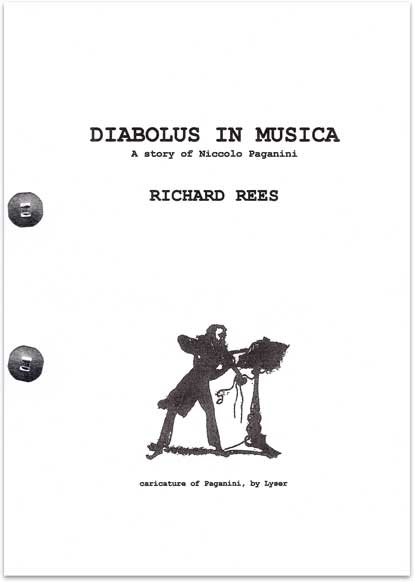
Diabolus in Musica, A Story of Niccolo Paganini
I’m publishing DIABOLUS IN MUSICA, A STORY OF NICCOLO PAGANINI, in screenplay format rather than as a novel. Why? There are many answers to this. The first – Why Paganini? – resulted from when, at the age 17, I drove my favourite Uncle Fred to hear Yehudi Menuhin, the finest violinist of the 20th century, give a Sunday evening recital at the International Music Festival at Llangollen, North Wales. Menuhin was brilliant, as always, that night, we were both enthralled, but later, driving back home, when I told Fred how gripped I’d been, he agreed, only to add, “But how I wish I could have heard Paganini play.”
Never having heard of Paganini, I asked who he was, and Fred replied, “The greatest violinist that ever lived, and still is, and always will be.”
He then told me more about Paganini. How he was the world’s first music idol, packing theatres throughout Europe, with people flocking to see him – somewhat similar to the later effect of Beatlemania, Elvis Presley, and Tom Jones – how he could play 20 notes a second, only for the Church of Rome to attribute his mesmeric playing to a Faustian pact he’d made with The Devil, a belief it still held up to his death in 1842, causing it to deny his body a burial in consecrated earth, or allow him a Requiem Mass.
The story stayed with me, mostly in the dim recesses of my mind, but then, after selling my accountancy practice to try to become a writer, and the success of my first novels, The Illuminati Conspiracy and The Reikel Conspiracy, my thoughts returned to it, and between writing more books, and then caring for my young wife and even younger daughter in their vain fights against ovarian cancer (told in my book, Dear Abigail – its proceeds go to Target Ovarian Cancer) kept thinking of writing Paganini’s story. A novel – The Magic Bow – came out in 1940, and a film of it in 1946 but, in all honesty, I thought neither did him justice, telling only a part of his life, and decided it would be my next book, telling all about him as he deserved to be told.
And so I booked into a London hotel, and began my research in the old British Library, but within a week realised his life was so full – one biography of him took 3 volumes – that a novel would take at least 2,000 pages, far too long. Consequently, I decided to try to tell his story filmicly, condensing the most climactic parts of his life into a 120-page screenplay, the maximum length for a spec script.
I finally completed it and luck – as I then thought – was with me when a Hollywood film company not only expressed interest in it, but entered into negotiations about it … only for a bomb to be dropped into my lap when Bernard Rose, the Oscar winning director of Immortal Beloved, about Beethoven, announced he had started production on his own screenplay, “Paganini, The Devil’s violinist”. And my negotiations immediately ended.
However, and most unexpectedly, Rose’s film wasn’t a success, focusing, as did The Magic Bow, on only a part of his life, and my hopes for DIABOLUS rose again. I realised it would have to wait some years for Rose’s film to be forgotten before I could try again to sell it. During this time I kept returning to it to improve and improve it as best as I could, and also attended a Robert McKee seminar, the best thing I could have done. I then decided I would give it another shot and sent it to another film company – and a film agent to represent me (both London-based for this submission) – only to get automated replies from them that my work had been received but it would take at least 12 weeks before they could look at it, and should I not hear from them after that time … (well, you can guess the rest).
I’m afraid that got my dander up. Paganini’s story is a great story and I feel it should be told. And so I decided to say “nuts” to both companies and publish it as a book, but still in screenplay format, for others to read about him, and hopefully enjoy.
It can be bought on Amazon through this website, and to those of you who decide to read it, then assuming you have imaginations, as even readers of books should have, its screenplay format shouldn’t detract you from (hopefully) enjoying it. Take its opening scene, for example, as given below:
Dawn breaks on the horizon as black horses speed a black coach south across France. Embossed on its doors is a gold letter P
It goes past a MILKMAID herding two cows. She drops her stick, crosses herself, babbles a prayer. Outside a roadside cottage, a MOTHER bundles a little boy and girl inside, slams door shut.
The coach crests a rise. Below is Nice.
Written as a book, I would describe the horses’ rolling eyes, froth flecking from their mouths and nostrils, the coachman’s black cloak rising up behind him, the milkmaid’s smock etc., etc., but in a script this is for the director to decide and focus on. As for readers, then you, too, can decide and focus on it all for yourselves in your mind’s-eyes as you read.
Your imaginations, if vivid enough, can and will be your own screens.
And so, here it is. DIABOLUS IN MUSICA. A STORY OF NICCOLO PAGANINI. Should you decide to buy, I sincerely hope (as I’ve already said) that you enjoy it. And should anyone wish to write to me regarding it, or chat about screenplays in general, please feel free to contact me through my email address given on this website.
With the sincerest of best wishes,
Richard Rees





